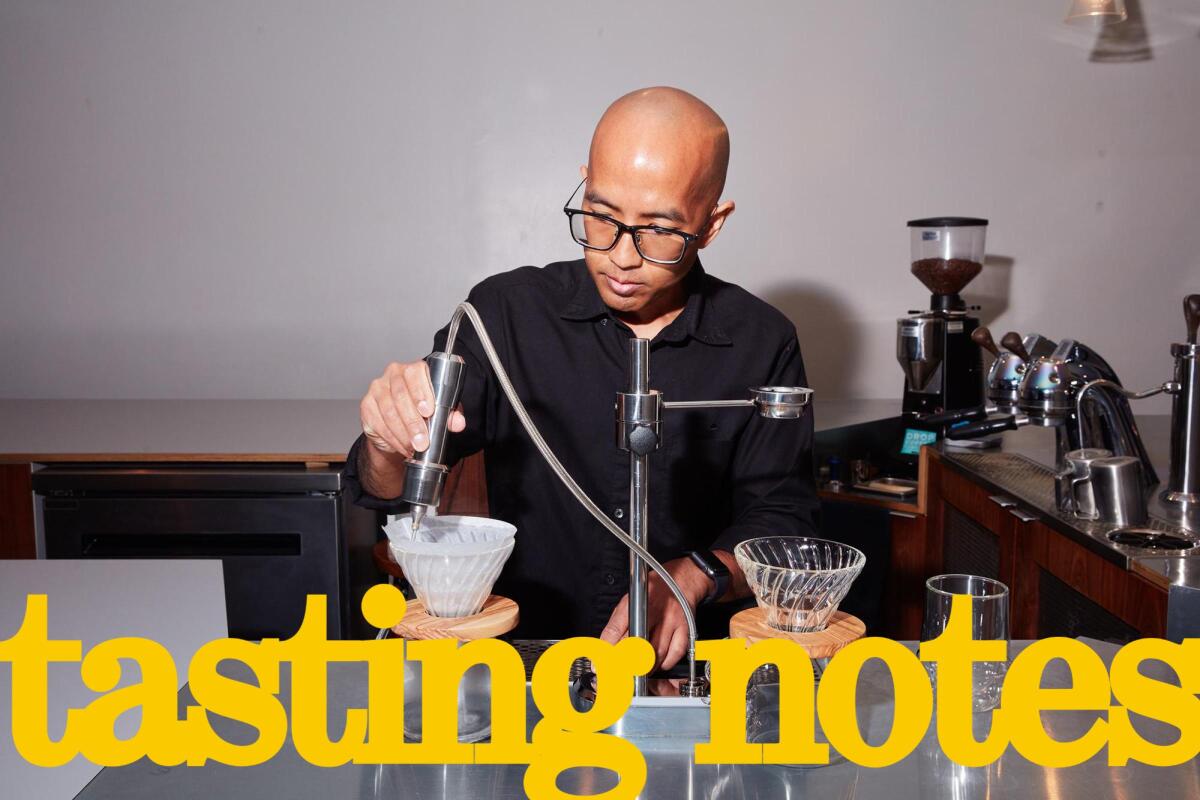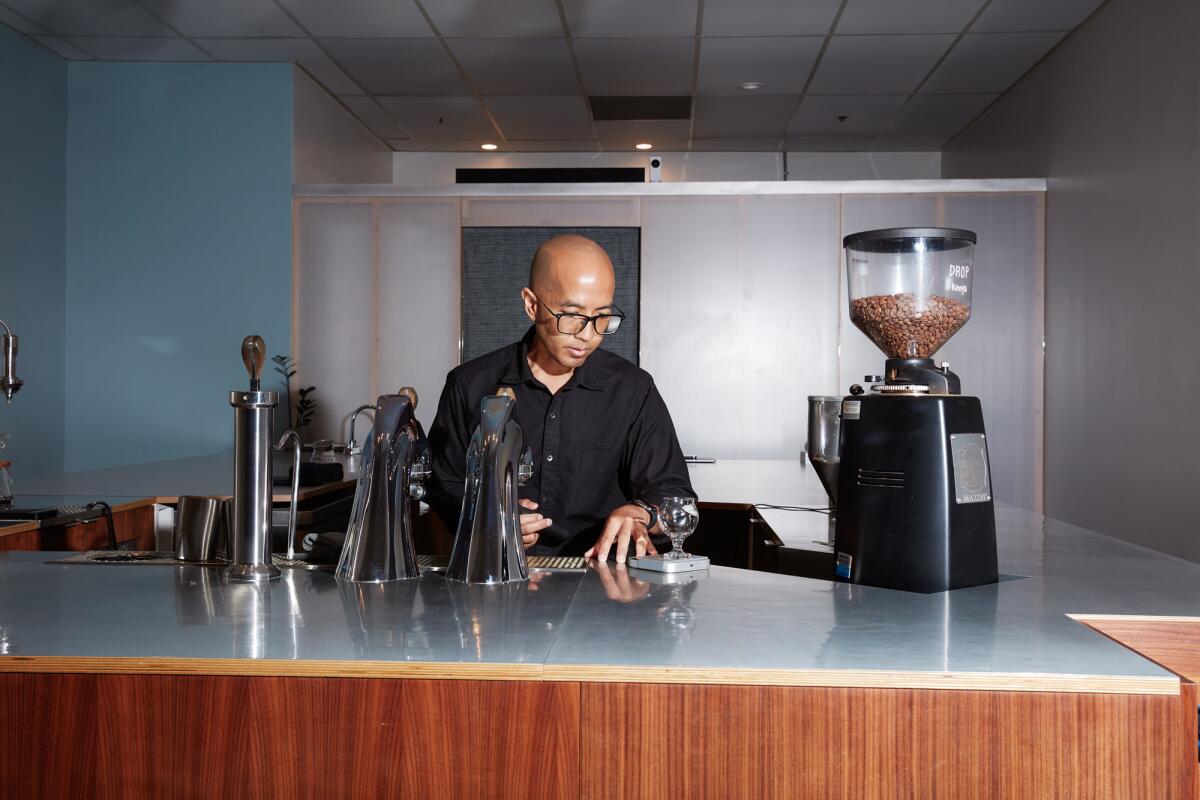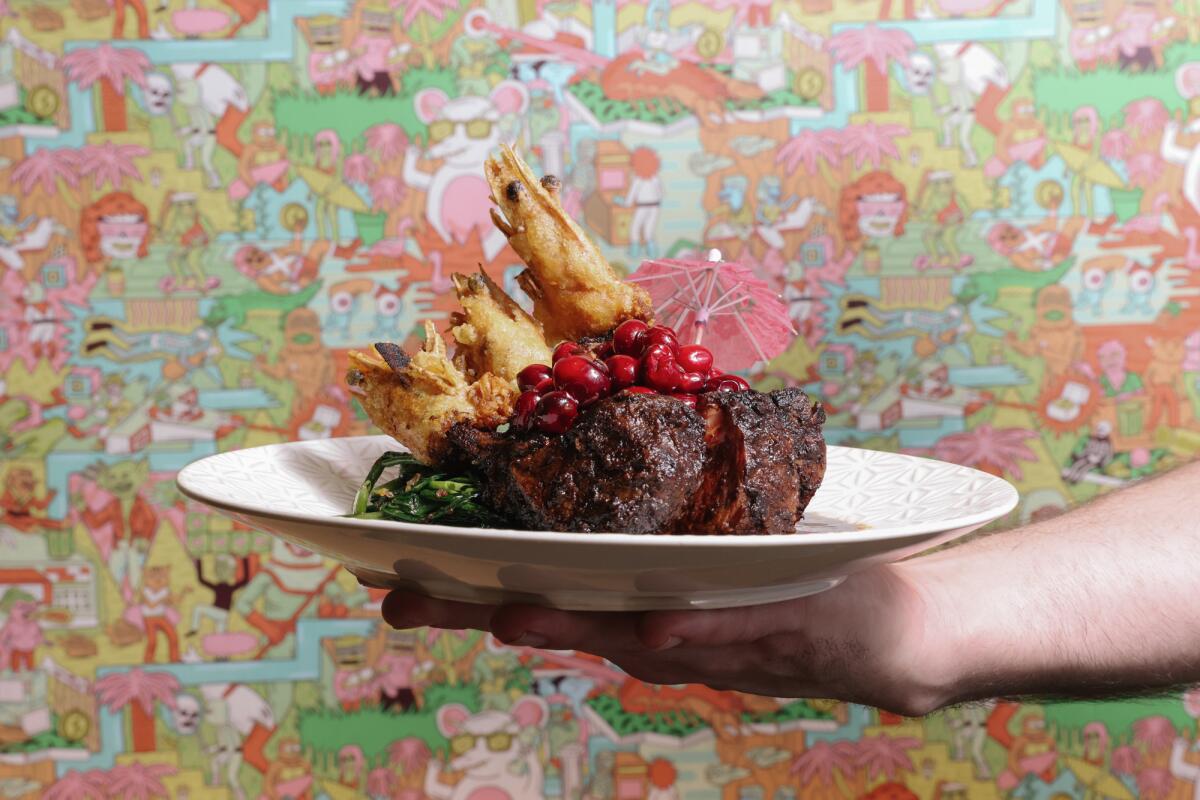Learning the secrets of coffee-making from an L.A. master

“I tend to let the water do the heavy lifting,” Jack Benchakul said about his approach to coffee as he tipped coarsely ground beans into a funnel-shaped Hario V60. The statement led to a discussion of alkalinity and hardness in water, of the roles that bicarbonate and calcium and magnesium play in the perceptions of flavor. Taking a sip of coffee that Benchakul brewed moments before, I picked up notes of stone fruit and spice in ways that made me think of peach crisp. I was never much of a chemistry student; a quest for the perfect cup of coffee might be the only thing that could spark my interest.
I was sitting in the high church of caffeine geekery — a class that Benchakul was teaching about pour-over technique on Valentine’s Day. Most of the eight students gathered around the coffee bar at Endorffeine, the Chinatown shop he runs with his cousin Ttaya Tuparangsi, were coffee professionals; I gathered this from the questions about water temperatures, flow rates and the differences in flavor development between the “first crack” and “second crack” stages of coffee roasting. It was as fun for me to watch the wheels spinning behind people’s eyes as it was to absorb what Benchakul was saying.
Enjoying this newsletter? Consider subscribing to the Los Angeles Times
Your support helps us deliver the news that matters most. Become a subscriber.
The lesson was a fitting apex to a month of driving, imbibing and all-around deep-diving on coffee culture in Los Angeles. The Times published an extensive project on the subject by the Food team this week.
Astrid Kayembe writes about the advent of Black-owned coffee shops across L.A.; the communities they create and center; and the drinks, like the Black Rose latte at Hilltop Coffee + Kitchen, that honor Black culture. She and Danielle Dorsey also compiled a mapped-out guide to Black-owned coffee shops.
Betty Hallock investigates the rise of designer instant coffee. She assembled a panel of Food staff and coffee professionals who tasted their way through some standouts — and pinpointed some frozen-capsule variations that may well be the future of excellence in immediate coffee gratification. Lucas Kwan Peterson, who was among the tasters, writes separately of his go-to instant coffee with additional tasting notes of other brands.
Julia Wolfson has tips from local roasters on buying beans for home brewing and deciphering industry jargon. Jenn Harris dips into the history of the espresso martini and why it’s never going away. Stephanie Breijo writes about Sherry Gao’s new Mandarin Coffee Stand in Pasadena and her efforts to highlight the quality beans being farmed in China.
I’m taken with Mandarin too: It’s among my 19 favorite coffee bars across Metro Los Angeles.
I also wrote an essay about my journey into L.A.-centric coffee obsession, in which Benchakul plays a large part. More of a longtime tea drinker, I started making pour-overs at home following the March 2020 shutdowns. Tasting the ones Benchakul brewed became a yardstick; was it even possible to make something this nuanced and delicious at home?
Eat your way across L.A.
Get our weekly Tasting Notes newsletter for reviews, news and more.
You may occasionally receive promotional content from the Los Angeles Times.
Everything we consume is personal by definition, but our relationship to this drink we guzzle as ritual and stimulant is among the most subjective. It was fun to consider the spaces between individual preference and public discourse. Excellent pour-overs do require some skill. Discussions of them can descend quickly into tiresome pretense — and plenty of people online are gleeful to call out any such whiffs.
Part of Benchakul’s feats have to do with his self-effacing earnestness. He’s a biochemist turned pastry chef turned barista. Of course he’s going to want to talk about water chemistry to anyone who will listen! And to everyone else: He’s the quiet guy making your unusually smooth cup of coffee; no further exchange is necessary.

He and Tuparangsi are taking a monthlong break for most of March, by the way, so if you haven’t tried Endorffeine’s pour-overs or precision-engineered espressos, this is the time. I won’t say much more about the class — Benchakul’s knowledge is his to share; the next one is scheduled for April — but I will say that my pour-overs are tasting markedly sweeter (without adding sugar, to be clear).
OK, I will share one thing to make pour-over haters’ eyes roll like dice. Benchakul suggested drinking coffee brewed from exceptional beans in a brandy snifter or other big-bowled stemware — the idea being that, as with wine, the vessel makes a difference in discerning flavors. It feels ridiculous to be starting my day clutching a bulbous glass I’d otherwise use only when a collector friend trots out a well-aged Bordeaux. I’ll revert back to a mug soon enough, but Benchakul is right: This is the step that brought me closest to sipping a pour-over at home that tastes like his masterworks.
Have a question?
More from L.A. Times Food
— Stephanie Breijo’s weekly report on restaurant news features a look into Poltergeist, the restaurant project inside the Echo Park arcade and bar Button Mash. The chef is Diego Argoti, who most recently masterminded the series of Estrano Things pop-ups in the space and elsewhere over the last year.
— Jenn Harris takes a trip to Exotics Only in a South Gate shopping center. “[It] sounds like the sort of place that sells adult movies, handcuffs and evocative roleplay costumes,” she writes. “The name showed up recently as I was scrolling through my TikTok feed. It did not turn out to be an account full of NSFW content. It was a wonderland of international snacks.”

Eat your way across L.A.
Get our weekly Tasting Notes newsletter for reviews, news and more.
You may occasionally receive promotional content from the Los Angeles Times.



